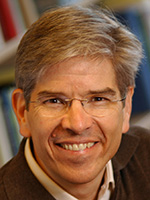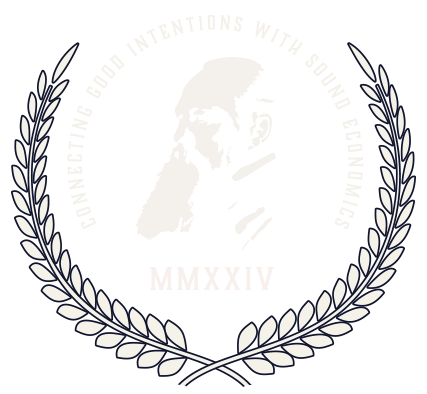Just last week I was telling a colleague that I hoped Paul Romer would finally win the Nobel prize in economics.
And then he did.
I’ve been a Paul Romer fan since I started teaching intermediate macroeconomics more than a decade ago—the “macro” course college students might take following the introductory one. Because most economics teaching involves good storytelling, I’ve thought a lot about how Romer fits into the story of how economic thinking about economic growth has evolved and changed over the last several hundred years. Professor Romer’s theory of long-term growth is one that fits the facts, and also helps us understand that it’s individuals that motivate lasting, perpetual growth.
It’s individuals that motivate lasting, perpetual growth.
The original growth theorists weren’t all that hopeful. They knew more was possible because they were witnessing actual, measurable growth for the first time in human history. Prior to the industrial revolution the average human being earned an estimated annual income, in today’s money, of roughly one hundred dollars. And in many ways life before that revolution was indeed nasty, brutish, and short. Infant mortality was high, we knew nothing about germ theory, and no one had indoor plumbing.
Classical economists -- economists like Adam Smith -- understood that human beings, for the first time, were beginning to create more wealth than ever before. In fact, it’s no accident that the title of Smith’s most famous book is literally An Inquiry into the Nature and Causes of the Wealth of Nations. Smith wanted to -- again, quite literally -- ask why nations were getting wealthy.
But Smith and his Classical contemporaries never conceived of what we know today: that economic growth might possibly be boundless. In the Classical view, temporary advances were possible anytime that people engaged in exchange or experienced productivity gains from activities like forming assembly lines (think of Smith’s famous pin factory example).

But in the Classical view, anytime society experienced a productivity gain that led to an increase in the wages of workers -- because they could now create more value per hour and thereby command a higher wage -- people would respond by having more children since they felt like they could now afford them. As soon as those children were old enough to go to work, they would immediately increase the labor supply and wipe out any earlier wage increases caused by productivity gains. The conclusion of Classical growth theory was that society would never rise above a subsistence wage: anytime wages increased due to productivity gains, the ensuing new births would eventually lead to an equal reduction in wages once all those new babies entered the labor force.
Talk about a dismal science.
It took a while, but growth economists eventually looked around and noticed that global per capita GDP was rising -- which meant that incomes were rising even faster than the population. So economists needed a new theory since the Classical model of growth didn’t fit the facts -- at all.
How did economists explain that incomes could grow faster than populations? The landmark model that supplanted the Classicals’ ideas is most often referred to as the Solow growth model in honor of another Nobel laureate, economist Robert Solow. In the Solow theory of economic growth, technological advances take center stage: As long as we continue to discover new ways of more effectively utilizing people and the tools they use, then everybody can create more value in an hour, and everyone can earn more per hour.
Solow’s contribution wasn’t entirely his own: He owed a lot to Joseph Schumpeter and his cycles of “creative destruction.” Every new technological discovery requires new capital goods that harness the new technology, and workers need to adapt to the new modes of production to remain employed -- albeit at higher wages.
But Solow didn’t answer a fundamental question: Where do new technologies come from?
In the Solow growth model new technologies “happen.” Economists would say that technological advances are “exogenous,” or developing from external factors. Solow doesn’t explain what causes technological change; he merely assumes it.
People -- motivated by profit, inquisitiveness, and necessity -- are the drivers of the discoveries that lead to long-term growth.
Which is what makes Romer’s contribution to growth theory meritorious, elegant, and clever. Romer’s class of models that endogenize technological advances are alternatively referred to as “new growth theory” or “endogenous growth theory.”
And where does Romer say new technology comes from? It comes from you and me. People -- motivated by profit, inquisitiveness, and necessity -- are the drivers of the discoveries that lead to long-term growth. Engineers and entrepreneurs and financiers and innovators make the discoveries that lead to growth. Their discoveries can be replicated and extended, and their work never ends. Whether people value professional achievement, fame and fortune, or the feeling of solving a really tough problem, they keep discovering. So according to Romer’s growth theories, an economy is like a perpetual motion machine: The ride is rarely smooth, but boy is it thrilling!
Now if you have read any coverage at all of the Nobel prize in economics this year you know that I have not mentioned William Nordhaus—who shared this year’s prize with Romer. But that’s because Nordhaus’s work also relied on the Solow growth model as a starting point. Though Nordhaus doesn’t get as far as incorporating Romer’s endogenous growth models in his work, he nevertheless make a brilliant contribution of his own: he incorporates the Solow growth model in Nordhaus’s models of the interactions of economic activity and CO2 concentrations. Nordhaus’s work pulls together a sophisticated understanding of the environment with Solow’s understanding of the significance of technological advances as a driver of sustained long-term growth. And Romer reminds us of the ultimate source of those new technologies: creative people being creative.
So let’s celebrate the contributions of this year’s economics laureates. They highlight a fact that Solow himself pointed out several years ago: It’s the creative potential of human beings that can ultimately achieve a sustainable future for us all.
Image "Nobel Laureate Paul Romer" credit: Wikimedia Commons (CC BY-SA 2.5). Cropped.













